| Back to Back Issues Page |
 |
|
Bangkok Travelbug Dec 2017 Fish Sanctuaries in Nakhon Chaisi December 08, 2017 |
| Hello
Tha Chin River The Tha Chin River branches off from the Chao Phraya River just south of Chai Nat about 200 km north of Bangkok and flows through Suphanburi, Nakhon Pathom and Samut Sakhon before flowing out to the Gulf of Thailand at Samut Sakhon. Considering all the bends and turns in the river, it's length is more than 220 km. The river got its name (tha – port, chin – Chinese) back in the 19th C when many Chinese trading junks anchored at the estuary to trade with the locals. Initially the name applied to the estuary and later to the whole river. It is a common local practice that where a waterway passes through a certain area, it adopts the name of that area. When the Tha Chin River passes through Nakhon Chaisi district, it's called Nakhon Chaisi by the locals. The Tha Chin basin like the Chao Phraya basin is a low lying and fertile farming area for rice, orchids, fruits and vegetables. 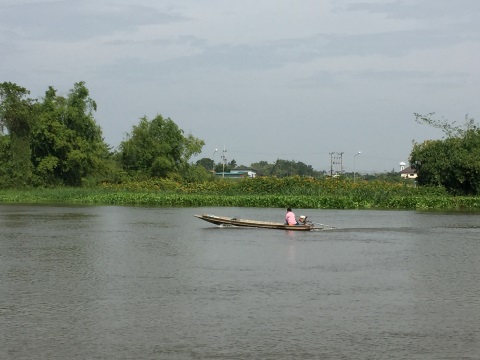
The Tha Chin off Wat Huai Phlu The river also has an abundance of fish of various types. With temples along the banks, these made ideal locations for fish sanctuaries where visitors come to feed the fish and spend a relaxing day in the country. Contents Wat Huai Phlu Our first stop in our drive through Nakhon Chaisi was at Wat Huai Phlu. The information board outside the viharn had only scant information on the temple. Other than the fact that it was built during the Ayutthaya period, little else was available. 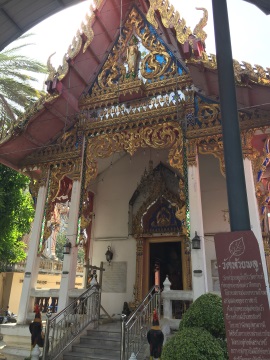
Viharn 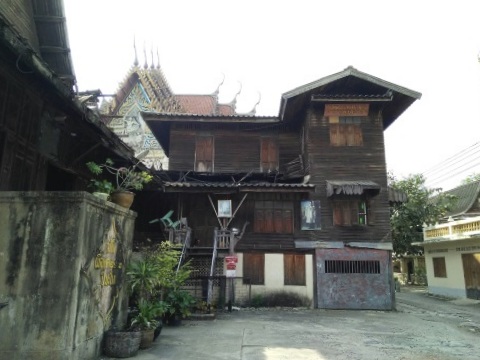
Kuti – monks' quarters I thought this stone, outside the monks' quarters or kuti, with the date of construction, would give an idea of the age of the temple. However, the date is BE 2483, that is 1940. It's too recent and probably referred to the date of construction of the kuti. 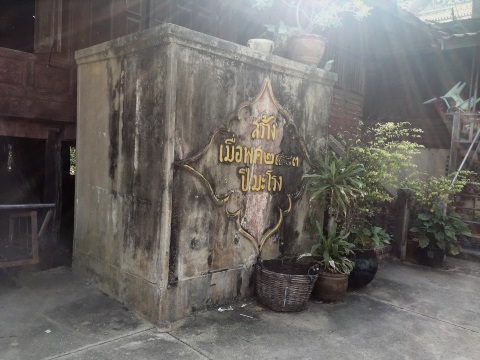
Date of construction of kuti? The other temple buildings were down a path with trees on either side giving the place a forest monastery atmosphere. 
Path leading to the temple buildings There were several old chedis among the trees. I learnt later that these were places where the remains of the dead were enshrined. The whole place had a rather eerie atmosphere. 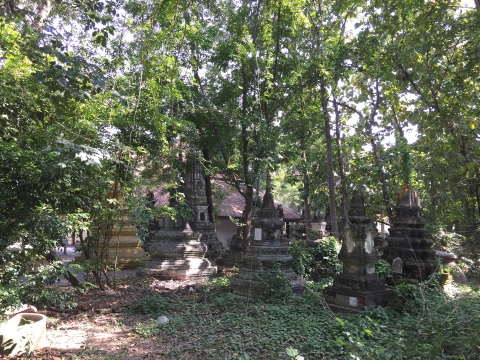
Chedis along the way In sharp contrast on the opposite side of the temple grounds, there was a market selling all kinds of goods. This market is open on Wednesdays and Saturdays. Most of the stalls were in full swing by 10 or 11 in the morning. 

The bi-weekly market Work was in progress to raise the river bank to prevent further floods in this low-lying river basin and a paved walkway has been constructed along the river bank. 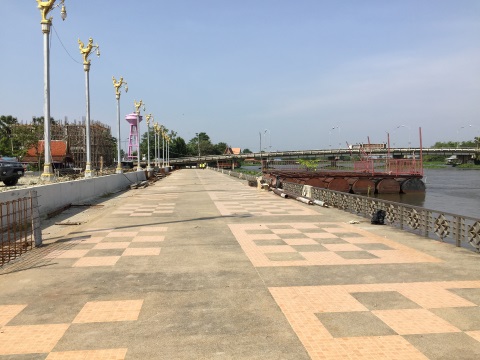
Walkway along the bank The fish were teeming just below the water's surface. Unfortunately, there was no one selling any fish food for us to get the fish to surface. 

Lurking below the surface In a sala (pavilion) by the river bank, we met a senior gentleman and asked him for more information about Wat Huai Phlu. He helpfully agreed to take us on a tour of the old buildings. Lung (uncle) Jamnian is 80, he's hale and hearty and walks at a sprightly pace. His advice to stay healthy, "Walk everyday". Lung was born here; his home is about two km from Wat Huai Phlu. He grew up in Nakhon Chaisi and spent most of his life here. Currently he spends his days in the temple selling amulets outside the viharn and chatting with residents at the sala by the river where we met him. 
Lung Jamnian showing us around the ubosot During the tour of the ubosot, Lung told us that the chapel was old and crumbling. The temple couldn't get approval for funds from the Fine Arts Department to preserve the building and had to take measures on their own to hold up the walls. 
Steel bars to support the pillars 
Extending the base of the walls to reinforce them The walls around the ubosot are filled with the remains of the dead. Within the walls around the ubosot, there are four chedis at each corner also for the same purpose. So are the chedis in the wooded area around. Lung mentioned that the remains of his ancestors are kept here too. 
Chedi at each corner Some of the niches where the remains are kept are in bad shape, almost crumbling. From the names inscribed, we could see that some high-ranking people have been put to rest here. 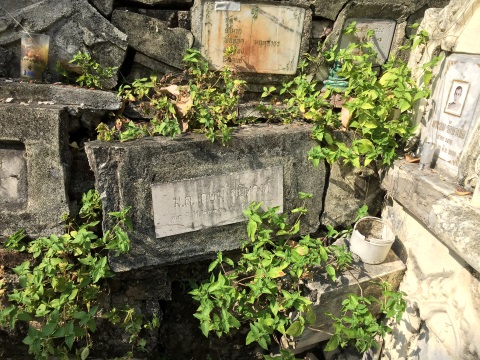
Remains of a Mom Luang – a person with a non-hereditary royal title 
The remains of a Rear Admiral Though we didn't get to see the fish, we were glad to have met Lung, a resident who showed us around and gave us some local information. Next, we proceeded to the other temple upriver where hopefully we would see the fish. Contents Wat Bang Phra Wat Bang Phra further upriver had a comparatively more cheerful atmosphere. There were many visitors when we got there and the vendors were doing a brisk trade. This temple was built in the late Ayutthaya period in the 1660s. Some of the buildings were rebuilt in the 1920s. There is also a building with a signboard indicating a museum but unfortunately it was locked up. 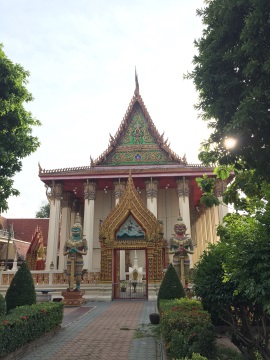

The newer buildings It was this old ubosot from the late Ayutthaya period, around 1667, that caught our attention. It has several Buddha statues inside and some very old and faded murals on the walls. Legend has it that these statues were transported by boat down river to escape from the Burmese invasion. The boat sank near the site of Wat Bang Phra. 
The old chapel from the late Ayutthaya period 18th C 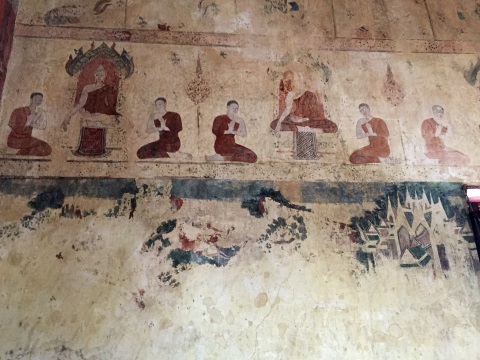

The faded murals on the inner walls The fish sanctuary in Wat Bang Phra has got to be seen to be believed. As visitors threw fish food in the water, the fish were swarming over one another in a feeding frenzy. The fish here are huge. 
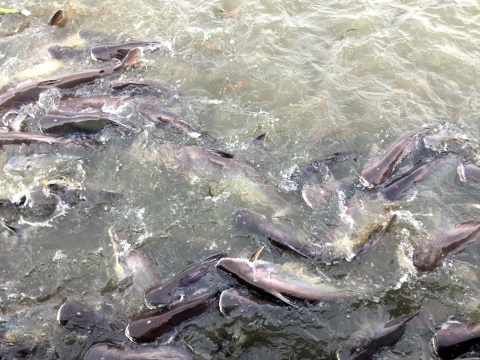
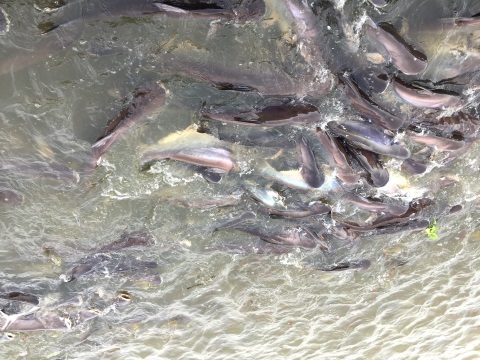

Feeding frenzy There's a small park with a waterfall dedicated to a former abbot of Wat Bang Phra, Luang Por Pern (1923 – 2002). The bridge across the Tha Chin is named after him as well. He was instrumental in building this bridge to help farmers bring their produce over to the market. 
Park and waterfall dedicated to Luang Por Pern 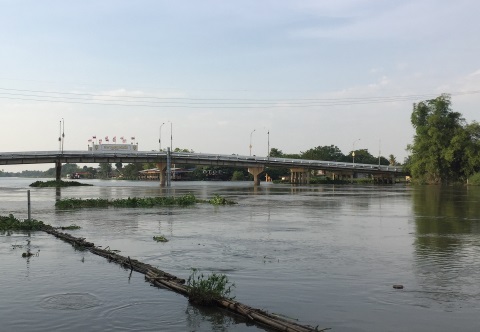
Luang Por Pern Bridge – the east is to the right At the end of the visit, we crossed over to the east bank of the Tha Chin using the Luang Por Pern Bridge. The drive back took us through more farmlands in the area that's north of the Mahsawat Canal and highway 4006. After a long drive and several turns, we finally emerged near Wat Suvarnnaram, got on to highway 4006 and on our way home. It has been a wonderful Saturday outing through the countryside in Nakhon Chaisi. It leaves me now to close 2017 and wish all our readers a Merry Christmas and a Happy New Year! Have a warm and joyful holiday with your family and friends. Contents Our thanks Our thanks to Lung Jamnian for taking us on a tour of Wat Huai Phlu and for sharing the story of his life with us. Thank you for adding that local flavour. 
Lung Jamnian Contents Map to the Wat Huai Phlu and Wat Bang Phra If the map doesn’t appear, click on this link How to get there By car Starting from the Mahidol University Salaya, proceed along highway 4006, the Salaya – Nakhon Chaisi Road. Go all the way to the Tha Na Market, across the river into Nakhon Chaisi Town. Turn right to highway 3233 and continue on till you reach Wat Huai Phlu. From Wat Huai Phlu continue on highway 3233, then turn right to highway 4014 to Wat Bang Phra. Note: Along the way on highway 4014, you will come across a temple called Wat Klang Bang Phra. That's a different temple altogether. Opening times Everyday 0800 – 1700 hours The market in Wat Huai Phlu is open on Wednesdays and Saturdays, 1000 – 1700 hours Admission - free Contents Next month Wat Klang Koo Vieng floating market If you enjoyed reading this e-zine, please forward it to a friend. If you received this from a friend and found it interesting, please subscribe at Bangkok Travelbug. What do you think of the Bangkok Travelbug? We love to hear from you What other subscribers have said Till next month then. Eric Lim Tour Bangkok Legacies Find us on Facebook My Journey through Thailand Part I The First Steps This is my second e-book and the first in the series of travel journals on my trips to explore the various provinces in Thailand. This edition, which covers my travels from late 2009 to mid-2013, will guide you to historical sites, cultural monuments and exquisite Thai handicraft, across a vast spectrum of cultural and ethnic diversity. You can have a virtual tour with this e-guide book or take the first steps yourself in this journey through Thailand. My Kindle e-book 
Copyright@2008-2017 Tour Bangkok Legacies All rights reserved |
| Back to Back Issues Page |

